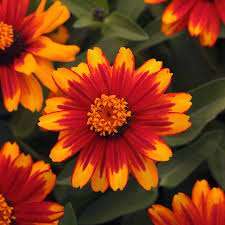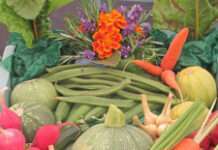ORNAMENTALS
Caddo Sugar Maples
Sugar maples often have significant problems with our Kansas weather. Our hot, often dry summers and windy conditions can shorten the life of these trees. However, some sugar maples are better adapted to Kansas conditions than others. Our John C. Pair Horticulture Center has evaluated sugar maples for well over 20 years and has identified selections that are much better adapted to Kansas. Of particular interest are the Caddo sugar maples which originated from an isolated population in Caddo, County, Oklahoma. These are true sugar maples and are considered an ectotype and are more drought tolerant, better adapted to high pH soils and more resistant to leaf scorch and tatter than the norm. Just how resistant to scorch is impressive. The last three weeks of August in 2003 saw temperatures at our research station over 100 degrees each day with no rain for the month prior. All other sugar maples in the trial had severely scorched leaves. Not a single leaf of any of the Caddo maples was scorched. Leaf water potential readings taken pre-dawn showed all other trees in the trial past the wilting point while the Caddo maples were barely stressed.
Another interesting characteristic of Caddo maples is that they tend to retain their leaves in the winter and therefore have been suggested as screens or for use in windbreaks. Dr. John Pair, the late director of the Horticulture Center, selected and released two Caddo maples over 10 years ago. Both these selections color early and have consistent good red fall color. Drought tolerance and resistance to leaf scorch and leaf tatter are exceptional. However, neither will do well in a heavy clay soil that is frequently saturated. These trees can be damaged or killed if planted in wet sites.
The first selection, ‘Autumn Splendor’, has the traditional sugar maple growth pattern and needs plenty of room to mature. ‘John Pair’ is smaller and more compact and more likely to fit a residential landscape. This tree is also noted for a dense, uniform crown. Flashfire is a third Caddo maple that has done well in Kansas. If you are in the market for a sugar maple, consider these before making a final decision. (Ward Upham)
MISCELLANEOUS
All-America Selection Winners for 2021
All-America Selections tests and introduces new flowers and vegetables each year that have done well in trials across North America.
Descriptions and images below are taken directly from All-America Selection materials. For more detailed information including how to grow, see https://all-americaselections.org/product-category/year/2021/
Vegetables
Echalion Creme Brulee (BGS-270) F1
2021 AAS Edible – Vegetable Winner
This echalion is the first-ever shallot to win the AAS Winner designation so it’s exciting to see such a beautiful and great tasting variety join the ranks. Growing a shallot from seed is fun and unexpectedly easy. Easy to peel, single-centered bulbs have a bright coppery pink outer skin and a pretty rosy-purple interior with thick rings. The sweet tender bulbs are earlier to mature than the comparisons and have a slight citrusy flavor when eaten raw. When caramelized, things get even better as the natural sugars are enhanced and do not leave any overpowering aftertastes. A fantastic variety for the home gardener as well as farm or fresh market growers.
Pepper Pot-a-peno F1
2021 AAS Edible – Vegetable Winner
Pot-a-peno is a fun new jalapeno pepper with a compact habit perfect for growing in containers and hanging baskets. Plentiful small, green jalapeño fruits have a traditional spicy zip that is great in any dish where you want a little punch of spice. Simply leave the fruit on the vine a few extra weeks and they will ripen to red for a sweet, spicy flavor. This variety is earlier to mature than other jalapenos giving you a head start on your garden’s harvest. A unique trait of Pot-a-peno is how the fruit hangs down beneath the plant making it very easy to harvest without damaging the appearance or productivity of the plant. A dense foliage canopy makes for an attractive addition to your patio or balcony garden.
Squash Goldilocks F1
2021 Edible – Vegetable Winner
Once upon a time, there was an acorn squash named Goldilocks. In summer trials all across North America, the vigorous plant, high yield, disease tolerance, and rich nutty flavor of this variety had our judges saying, “Ahhh, this squash is just right!” like in the fairy tale. The bright orange fruits with uniform shape and color double as an ornamental decoration. Makes a great complement to AAS Winner Honey Bear acorn squash.
Flowers
Celosia Kelos® Candela Pink
2021 AAS Flower Winner
You know it’s good when an AAS Judge calls an entry the “Energizer Bunny” that just kept blooming! Across the board, the judges loved the bright pink blooms that rose above the foliage, almost like a tall, tapered candle! Unique, showy plumes of pink flowers kept their color all season long and the judges agree that this is a perfect filler plant to add height and interest to a combination container planting. But it is also useful in mass plantings, borders, and general garden use. Another added bonus: it works as a dried flower.
Available in plant form only.
Leucanthemum Sweet Daisy Birdy
2021 AAS Perennial Winner
Sweet Daisy™ Birdy Leucanthemum is a beautiful perennial with robust, long-lasting blooms and carefree longevity in gardens down to zone 3. In the AAS Trials, it demonstrated excellent cold and heat tolerance and maintained a tidy, sturdy habit over the three-year trial. The cheery flowers are large and pure white in color, appearing earlier in the season than the comparison varieties. The 5 reflexed daisy blooms feature small feathery petals around golden yellow button centers. Leucanthemums, also known as Shasta Daisies, are used for both cut flowers and garden highlights while also providing food and habitat for many kinds of pollinators. Enjoy this beauty in the garden as a medium-height bright spot (great for moonlight gardens) that will provide years of beauty with very little maintenance other than deadheading spent blooms if desired, but not necessary.
Available in plant form only.
Zinnia Profusion Red Yellow Bicolor
2021 AAS Flower Winner
“JUST SO CUTE! WOW, WOW WOW!” When multiple judges write comments like that, it’s no surprise that it’s a Gold Medal Winner! Introducing…a beautiful new bicolor addition to the popular Profusion series of zinnias. This gorgeous zinnia starts the season with a bold vibrant red center ring surrounded by golden-yellow outer petals. As the season progresses, the aging flowers morph into soft, beautiful shades of apricot, salmon, and dusty rose to bring a plethora of color to the garden, all from one variety! Trial garden visitors clamored over this floriferous and compact plant during the summer trials noting how well the plant continued to bloom new flowers over old so there was never a decline in the beauty presented by Profusion Red Yellow Bicolor.
Profusion Red Yellow Bicolor is also the recipient of the Fleuroselect Gold Medal award for performance in European trials. (Ward Upham)
How to Tell Poison Ivy and Virginia Creeper Apart in the Winter
During the growing season, these plants are easy to tell apart as Virginia Creeper has five-leaflets per leaf and Poison Ivy has three. However, during the winter, distinguishing between the two vines can be more difficult as the leaves have dropped. The reason it is important to be able to tell the difference is that Poison Ivy causes a rash in most people but Virginia Creeper does not. First, let’s cover some facts about Poison Ivy.
– Urushiol is the oil present in Poison Ivy that causes the rash.
– Urushiol is present in all parts of the plant but especially in the sap.
– Urushiol can cause a rash from 1 to 5 years after a plant has died.
– The amount of urushiol that covers the head of a pin can cause a rash in 500 people. The stuff is potent.
– Poison Ivy can grow as a ground cover, a shrub or a vine. We are concerned with the vine in this article.
– Using a chainsaw on Poison Ivy in the winter can release sap which makes a rash more likely. This is worse on warm days where there is more sap rise.
So, how do you tell the two apart? This is actually easy once you know what to check. Look at the aerial roots on the vines of Poison Ivy and Virginia Creeper. They resemble hairs on Poison Ivy but are plumper on Virginia Creeper and are about the size of a pencil lead. (Ward Upham)
Pecan Blog
Dr. William Reid, the Pecan Research and Extension Specialist for Kansas and Missouri for 37 years, has an excellent blog on growing pecans in Kansas and neighboring states. In retirement, Dr. Reid is tending his 30 acre pecan orchard and continues to blog his observations. The blog is titled “Northern Pecans.”
If you are at all interested in pecans, this is a blog you must visit. Excellent photography accompanied by Bill sharing decades worth of experience makes this a gold mine of information. The URL is http://northernpecans.blogspot.com/ (Ward Upham)
Conservation Trees from the Kansas Forest Service
The Kansas Forest Service offers low-cost tree and shrub seedlings for use in conservation plantings. Plants are one to two years old and sizes vary from 8 to 18 inches, depending on species. Two types of seedlings are offered; bareroot and containerized. Containerized provide a higher survival rate and quicker establishment. Orders are accepted from now through May 1st, but order early to ensure receiving the items you want.
Orders are shipped beginning in mid-March. Approved uses for these plants include windbreaks, wood lots, wildlife habitat, timber plantations and educational and riparian (streambank) plantings. They may not be used for landscape (ornamental) plantings or grown for resale.
All items are sold in units. Each single species unit consists of 25 plants. For example, a unit of Eastern red cedar has 25 trees per unit. Though a single species unit is most commonly purchased, four special bundles are also available including a quail bundle, pheasant bundle, eastern pollinator bundle and western pollinator bundle.
Tree planting accessories are also available including marking flags, root protective slurry, rabbit protective tubes, weed barrier fabric and tree tubes. If there have been problems with deer browsing on young trees, the tree tubes are a must.
For details and an order form, go to: http://kfs.mybigcommerce.com/all-items/ Note that there are three pages of items that are accessed by clickable links at both the top and bottom of the listing. Order forms are also available from local K-State Research and Extension offices. (Ward Upham)
Contributors: Ward Upham, Extension Associate
Division of Horticulture
1712 Claflin, 2021 Throckmorton
Manhattan, KS 66506
(785) 532-6173
For questions or further information, contact: [email protected] OR [email protected]
This newsletter is also available on the World Wide Web at:
http://hnr.k-state.edu/extension/info-center/newsletters/index.html
The web version includes color images that illustrate subjects discussed. To subscribe to this newsletter electronically, send an e-mail message to [email protected] or [email protected] listing your e-mail address in the message.
Brand names appearing in this newsletter are for product identification purposes only. No endorsement is intended, nor is criticism implied of similar products not mentioned.
K-State Research and Extension is committed to making its services, activities and programs accessible to all participants. If you have special requirements due to a physical, vision or hearing disability, or a dietary restriction please contact Extension Horticulture at (785) 532-6173.
Ward Upham
Extension Associate
[email protected]
785-532-1438





